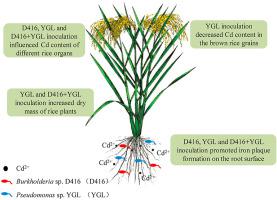Journal of Environmental Management ( IF 8.0 ) Pub Date : 2020-11-05 , DOI: 10.1016/j.jenvman.2020.111533 Ting Wei , Xun Liu , MingFang Dong , Xin Lv , Li Hua , HongLei Jia , XinHao Ren , ShengHui Yu , JunKang Guo , YongTao Li

|
Iron plaque is the amorphous and/or crystalline layer of Fe and Mn (hydr)oxides formed on the root surface of wetland plants. It could adsorb and co-precipitate metal(loid)s at the rhizosphere, thus modulating the uptake and accumulation of metal elements in plants. In this study, the Fe(II)/Mn(II)-oxidizing bacteria Burkholderia sp. D416 (D416) and Pseudomonas sp. YGL (YGL) were isolated from Cd-contaminated rice field, both hydroponic experiment and pot experiment were performed to assess the impact of bacterial inoculation on iron plaque formation, elemental content of the plaque, plant dry mass, antioxidant enzyme activity and Cd content in rice plants. The results revealed that inoculation with D416, YGL, and D416+YGL stimulated iron plaque formation on the root surface of the hydroponic rice. The content of C, N, O, Na, Mg, Al, Si, P, S, Cl, K, Fe and Ca in the root plaque were affected by the bacterial inoculation and varied among different plant growth stages. The pot experiment indicated that inoculation with D416 increased the root dry biomass by 58.89%, and the combined inoculation of D416 and YGL increased the dry biomass of root, shoot and grain by 16.89%, 21.66% and 23.26%, respectively. Importantly, YGL inoculation decreased the Cd translocation from root to shoot and from glume to brown rice grain by 50.00% and 50.27%, respectively, and the Cd content in shoot and brown rice grain were decreased by 20.00% and 34.48%, respectively. Taken together, the elemental content of the iron plaque and Cd content in rice plants varied among different plant growth stages and when plants were inoculated with different bacterial strains. YGL dramatically reduced the Cd content in brown rice grain, thus it could potentially be used to reduce Cd content in rice crop grown in Cd-contaminated soils.
中文翻译:

根际铁和锰氧化细菌刺激根系铁斑形成并调节水稻对镉的吸收(水稻(Oryza sativa L.)
铁斑是在湿地植物的根表面上形成的Fe和Mn(氢)氧化物的非晶和/或结晶层。它可以在根际吸附和共沉淀金属(胶体),从而调节植物中金属元素的吸收和积累。在这项研究中,Fe(II)/ Mn(II)氧化细菌伯克霍尔德氏菌。D416(D416)和假单胞菌sp。从镉污染的稻田中分离到YGL(YGL),进行了水培和盆栽试验,评估了细菌接种对铁斑块形成,斑块元素含量,植物干重,抗氧化酶活性和镉含量的影响。水稻植物。结果表明,接种D416,YGL和D416 + YGL会刺激水培水稻根表面铁斑的形成。细菌接种会影响根斑块中C,N,O,Na,Mg,Al,Si,P,S,Cl,K,Fe和Ca的含量,并且在植物的不同生长期中其含量也不同。盆栽试验表明,接种D416可以使根部干生物量增加58.89%,同时接种D416和YGL可以使根,茎和谷物的干生物量分别增加16.89%,21.66%和23.26%。重要的是,接种YGL可使Cd从根部到茎部以及从颖花到糙米粒的Cd转运分别降低50.00%和50.27%,并且芽和糙米粒中的Cd含量分别降低20.00%和34.48%。两者合计,水稻植株中铁斑块的元素含量和Cd含量在不同的植物生长阶段以及接种不同细菌菌株的植物之间都不同。YGL显着降低了糙米谷物中的Cd含量,因此可以潜在地减少在受Cd污染的土壤中种植的水稻作物中的Cd含量。两者合计,水稻植株中铁斑块的元素含量和Cd含量在不同的植物生长阶段以及接种不同细菌菌株的植物之间都不同。YGL显着降低了糙米谷物中的Cd含量,因此可以潜在地减少在受Cd污染的土壤中种植的水稻作物中的Cd含量。两者合计,水稻植株中铁斑块的元素含量和Cd含量在不同的植物生长阶段以及接种不同细菌菌株的植物之间都不同。YGL大大降低了糙米谷物中的Cd含量,因此可以潜在地减少在Cd污染土壤中种植的水稻作物中的Cd含量。
















































 京公网安备 11010802027423号
京公网安备 11010802027423号